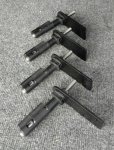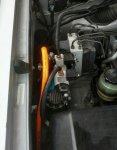Sal R.
Active member
MODIFICATION: Auxilary Lighting
GOAL:
Improve nighttime visibility.
PURPOSE:
A recent trip up the mountain in the dark to stargaze and watch the meteor shower had me rethinking my lighting. The trail I frequent was easy enough during the day, but at night, it got a little hairy trying to navigate thru the switchback with just the OEM lighting. I was going to wait until I had a front bumper, but that's going to be awhile, I think.
Despite the fact that I don't really wheel at night, this might not be the last time I take the opportunity to star gaze, either.
Coupled with the fact that winter is just around the corner, I thought that this might be the time to add some low level aux lighting for night trips and snow.
MATERIALS:
Rigid Industries 10" SR2 Hyperspot/Driving Combo Light
Rigid Industries D2 Dually Amber Driving Light
Relay and misc wiring
DURATION: 1 hour
COST: $550
HOW-TO:
I settled on the 10" Rigid Industries SR2 driving/hyperspot combo and the D2 Amber driving light for snow and dusty conditions. I didn't do the whole length of the bumper opening just because I wanted my light choices to be usable on my future bumper.
Removing the bumper skin is pretty simple.

Still looking at ditch lights solutions. I hear Rago Fab is doing cool stuff for the 1st gen Tundras...
GOAL:
Improve nighttime visibility.
PURPOSE:
A recent trip up the mountain in the dark to stargaze and watch the meteor shower had me rethinking my lighting. The trail I frequent was easy enough during the day, but at night, it got a little hairy trying to navigate thru the switchback with just the OEM lighting. I was going to wait until I had a front bumper, but that's going to be awhile, I think.
Despite the fact that I don't really wheel at night, this might not be the last time I take the opportunity to star gaze, either.
Coupled with the fact that winter is just around the corner, I thought that this might be the time to add some low level aux lighting for night trips and snow.
MATERIALS:
Rigid Industries 10" SR2 Hyperspot/Driving Combo Light
Rigid Industries D2 Dually Amber Driving Light
Relay and misc wiring
DURATION: 1 hour
COST: $550
HOW-TO:
I settled on the 10" Rigid Industries SR2 driving/hyperspot combo and the D2 Amber driving light for snow and dusty conditions. I didn't do the whole length of the bumper opening just because I wanted my light choices to be usable on my future bumper.
Removing the bumper skin is pretty simple.
- Remove some M6 bolts hidden under the fender liner on the DS/PS and under the bumper holding the fender liners.
- Remove misc push clips above and below bumper.
- Disconnect the fog lights (if you have them).
- Bumper just slides off.

Still looking at ditch lights solutions. I hear Rago Fab is doing cool stuff for the 1st gen Tundras...
Last edited:














































